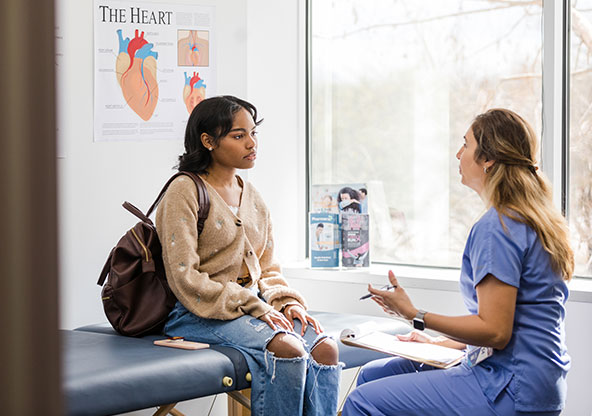What Parents Should Know About HPV and Cervical Cancer
January is Cervical Health Awareness Month
All right ladies (and parents of young ladies), this month is dedicated to the health of your cervix. But you hardly know each other, so before diving into an intimate discussion, how about we start with some introductions? Meet your cervix, the lower, narrow part of your uterus. The cervix forms a canal that opens into the vagina and the vagina leads to the outside of the body.
HPV and Cancer
Now with the introductions out of the way, let’s get “down” to your “business.” Cervical Health Awareness Month is an opportunity to share information about HPV and cervical cancer. HPV is the name for a group of over 150 viruses, some that cause warts and some that cause cancer. HPV is transmitted either by skin-to-skin or sexual contact.
According to the CDC, HPV is one of the most common sexually transmitted infections–almost 80 million Americans currently have it, 14 million more become infected each year, and many people do not even know they are infected.
Most of the time, the infection goes away by itself, but sometimes it can lead to:
- cancer of the cervix, vagina, or vulva in women;
- cancer of the penis in men; and
- cancer of the anus and back of the throat in both genders.
Cervical Cancer Screening (Pap tests)
Over the past 40 years, the rate of cervical cancer and cervical cancer deaths have decreased because of women getting regular Pap test screenings. Pap tests are recommended every three years for women 21-29 years of age and every three to five years for women 30-65 years of age. Check with your primary care physicians or gynecologist if you have questions.
HPV Vaccine
The HPV vaccine protects against nine types of HPV that most commonly cause cancer. It is approved for both boys and girls over the age of nine and is typically given as a two-dose series starting at the 11-year-old physical (because there are often other vaccines given at this visit).
Below are some myths about the vaccine debunked:
MYTH: “It’s hasn’t been studied long enough to check out side effects.”
FACT: The vaccine does cause side effects such as pain, redness, swelling at the vaccine site, fever, headache, nausea, and muscle pain, just as most other vaccines do. The only difference is that your preteen is able to tell you he is feeling this way and couldn’t tell you when he was two months old.
Additionally, because your preteen is free to get up and walk away after a medical procedure (in comparison to when he was two months old and lying flat), he will also be asked to stay in the clinic for 15 minutes to make sure he doesn’t get “woozy.”
The first HPV vaccine was licensed in 2006 and since then all three available HPV vaccines have been studied in almost 75,000 men and women. The vaccine is safe.
MYTH: “Why should my son have to get a vaccine to prevent cancer in a girl?”
FACT: HPV can cause anal, penis, and throat cancer and genital warts in males. It is just as important for your son to receive the vaccine as your daughter. And it isn’t any different from any other vaccine. Your son also received the whooping cough vaccine not only to protect himself from the whooping cough, but to also keep a community whooping cough-free.
MYTH: “It’s going to make my kid want to have sex.”
FACT: A recent study of almost 300,000 girls ages 12-18 years in British Columbia, Canada, revealed that receiving the vaccine did not increase engagement in sexual intercourse or risky sexual behaviors. While researchers could not conclude that the vaccine was a direct correlation, they did find that girls surveyed in 2013 after starting the school-based vaccination program were less likely to engage in sexual intercourse, less likely to have sex before 14, and less likely to become pregnant, compared to the girls surveyed in 2003 before the program started.
For more information about the HPV vaccine, talk to your child’s pediatrician. If you need to identify a physician for your child, please visit this page.

